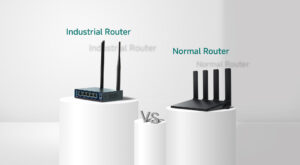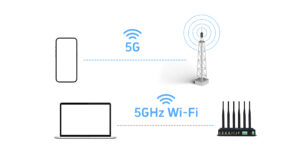Whether you’re designing an office LAN or building a network for a harsh industrial setting, understanding the difference between industrial switches and normal switches is crucial. Normal switches are tailored for typical business environments. In contrast, industrial switches are designed to handle extreme conditions like wide temperature swings, vibrations, dust, and even electrical noise.
Switch Port Differences
- Normal Switches: Include standard RJ45 Ethernet ports and sometimes SFP ports for fiber connections.
- Industrial Switches: Feature a more versatile port selection including RJ45, SFP, serial ports (RS232, RS485) for industrial automation, and M12 connectors for transportation or marine applications.
Industrial switches support both networking and serial communication, making them suitable for SCADA systems, legacy equipment, and machine interfaces.
Enclosure and Case Differences
- Commercial Switches: Typically made of plastic or thin metal, offering sleek, lightweight designs.
- Industrial Switches: Use rugged aluminum enclosures to resist corrosion, impacts, and extreme weather. Their designs are fanless and ventless to block dust and moisture.
Some models are even embedded directly into machines to save space. Contact us for the specs or quote of this kind of embedded ethernet switches.
Switching Protocols
- Normal Switches: Rely primarily on Ethernet and TCP/IP protocols.
- Industrial Switches: Support advanced, real-time industrial protocols like Modbus TCP, PROFINET, EtherNet/IP, and EtherCAT.
This difference is vital in automation environments where timing and reliability directly impact safety and productivity.
Mounting Options
- Normal Switches: Designed for desktop, wall mount, or rack mount installations.
- Industrial Switches: Offer DIN-rail, embedded, and panel-mount configurations. These are optimized for integration into control cabinets and machinery.
Power Supply Design
- Business Switches: Usually come with a single AC input, often through a standard socket.
- Industrial Switches: Feature dual redundant DC power inputs, wide voltage tolerance (9–56V DC or 100–240V AC), and secure terminal blocks.
They also meet strict safety standards for high-risk environments like power plants or mining operations.
Operating Temperature Range
- Normal Switches: Designed for 0–50°C, adequate for indoor use.
- Industrial Switches: Built for -40–75°C and tested under standards like IEC 60068.
This ensures performance even in freezing outdoor cabinets or hot production lines.
Cooling Strategies
- Commercial Switches: Use fans to dissipate heat, which can attract dust and eventually fail.
- Industrial Switches: Rely on passive cooling through robust aluminum casings with no moving parts. This improves longevity and reliability.
Final Thoughts
When comparing industrial switch vs normal switch, it becomes clear that the differences go far beyond the casing. Industrial switches are engineered for reliability, durability, and flexibility in the most demanding environments. From power resilience and extended temperature tolerance to rugged housing and protocol support, industrial-grade switches are the backbone of mission-critical industrial networks.
If your application involves factories, railways, mines, or outdoor systems, choosing an industrial Ethernet switch is not just a good idea—it’s essential.


